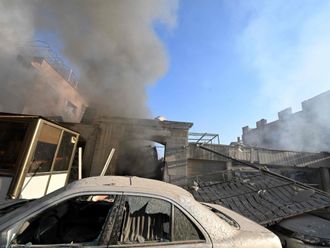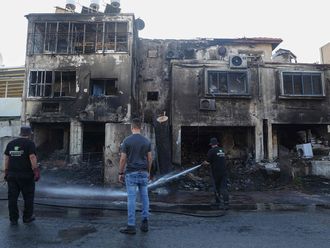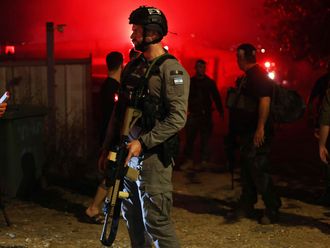
Los Angeles/Washington: The radar-evading drone that crash-landed over the weekend in Iran was on a mission for the CIA, according to a senior US official, raising fears that the aircraft's sophisticated technology could be exploited by Tehran or shared with other American rivals.
It was unclear whether the drone's mission took it over Iran or whether it strayed there accidentally because of technical malfunctions, the official said.
Though the drone flight was a CIA operation, US military personnel were involved in flying the aircraft, said the official, who spoke on condition of anonymity because of the secrecy involved.
The jet-powered, bat-winged RQ-170 Sentinel drone is considered one of the most advanced in the US arsenal, with stealth technology and sophisticated computer systems that enable it to penetrate deep into hostile territory without detection.
Its capabilities were demonstrated during the raid on Osama Bin Laden's compound in Pakistan, where it provided surveillance of the operation.
The aircraft's full abilities are a closely guarded secret, and the Pentagon has not revealed its price tag, size or top speed. But it has acknowledged this: The Sentinel may now be in Iranian hands.
Next generation
"I think we're always concerned when there's an aircraft, whether it's manned or unmanned, that we lose, particularly in a place where we're not able to get to it," Navy Capt John Kirby, a Pentagon spokesman, said to reporters on Monday.
Peter W. Singer, author of Wired for War, a book about robotic warfare, said it's not new to have drones downed in enemy territory, but the RQ-170 represents the next generation of drone aircraft.
"It carries a variety of systems that wouldn't be much of a benefit to Iran, but to its allies such as China and Russia, it's a potential gold mine," Singer said.
Other aviation experts weren't so sure.
"I don't think this is a dagger pointed at the heart of democracy," said Loren Thompson, defence policy analyst for the Lexington Institute in Arlington, Virginia. "A lot of information about this aircraft was already known by foreign military intelligence officials."
Ambiguous
On Sunday, Iran's armed forces said they brought down a Sentinel drone that violated the country's airspace along the eastern border. The North Atlantic Treaty Organisation's US-led force in neighbouring Afghanistan said Iranian authorities might be referring to an unarmed US reconnaissance plane that went missing during a mission in western Afghanistan late last week, but did not confirm what kind of aircraft was downed.
The Nato force's statement was ambiguous about who was flying the aircraft.
"The operators of the UAV [unmanned aerial vehicle] lost control of the aircraft and had been working to determine its status," the statement said.
Spokesmen for the CIA, White House, Pentagon and congressional intelligence oversight committees declined to comment.
Although the Sentinel's capabilities remain largely classified, it is believed to carry the latest in cutting-edge cameras and sensors that can "listen in" on cellphone conversations as it soars miles above the ground or "smell" the air and sniff out chemical plumes emanating from a potential underground nuclear laboratory.
Ever since it was developed at Lockheed Martin Corp's famed Skunk Works facility in Palmdale, the Sentinel drone has been cloaked in tight secrecy by the US government.
Photographs of the Sentinel first surfaced online in 2009 at a remote airfield in Kandahar, Afghanistan. The drone received the nickname "the beast of Kandahar".
The drone resembles a miniature version of the B-2 stealth bomber. The bat-wing design is meant to make it less likely to pop up on enemy radar screens. Also like the B-2 bomber, the Sentinel is thought to have high-tech coatings that act like a sponge to absorb radar waves as they strike the plane.
The Sentinel's design is a quantum leap from the MQ-1 Predator and MQ-9 Reaper drones well-known for hunting terrorists in the Middle East. Those drones, made by General Atomics Aeronautical Systems Inc of Poway, California, are propeller powered, non-stealthy and not designed to be flown in contested airspace.
The Pentagon first publicly acknowledged the Sentinel's existence in late 2009. The craft is known to be an unarmed spy drone.
Kevin Gambold, director of operations for Unmanned Experts, a British company that specialises in unmanned aerial vehicles, said the Sentinel, carrying an array of classified surveillance systems, would have a self-destruct mechanism to disable or destroy it if operators lost control.
He said it's difficult to believe that Iran could have brought down the aircraft with electronic jamming or by taking the controls through a cyber-attack as the country claims it did. "You never say never, but I would be gob-smacked and amazed if they even knew how," Gambold said.
John Bumgarner, the chief technical officer for the US Cyber Consequences Unit, an independent non-profit research institute, said it was technically possible to jam the communication used to control a drone.
However, in such instances, the drone should have a fail-safe mechanism that enables it to retrace its flight path and return to the base where it was launched, he said.
The most likely reason that the Sentinel did not self-destruct or safely return is that it was lost because of an onboard mechanical malfunction, said Thompson of the Lexington Institute.
"That means what the Iranians have is a pile of wreckage — many small and damaged pieces from which they could glean little in the way of technological insights," he commented.
Even then, the pieces of stealth technology may have found their way into foreign military hands before.
Earlier this year, China claimed that it had developed and built a stealth fighter jet, dubbed Chengdu J-20.
US military officials believe that the Chinese used technology collected from an F-117 stealth aircraft that was shot down over Serbia in 1999 during the Kosovo war. Chinese agents were said to have purchased parts of the plane, covered in high-tech stealth coating, from local farmers.
— Los Angeles Times












